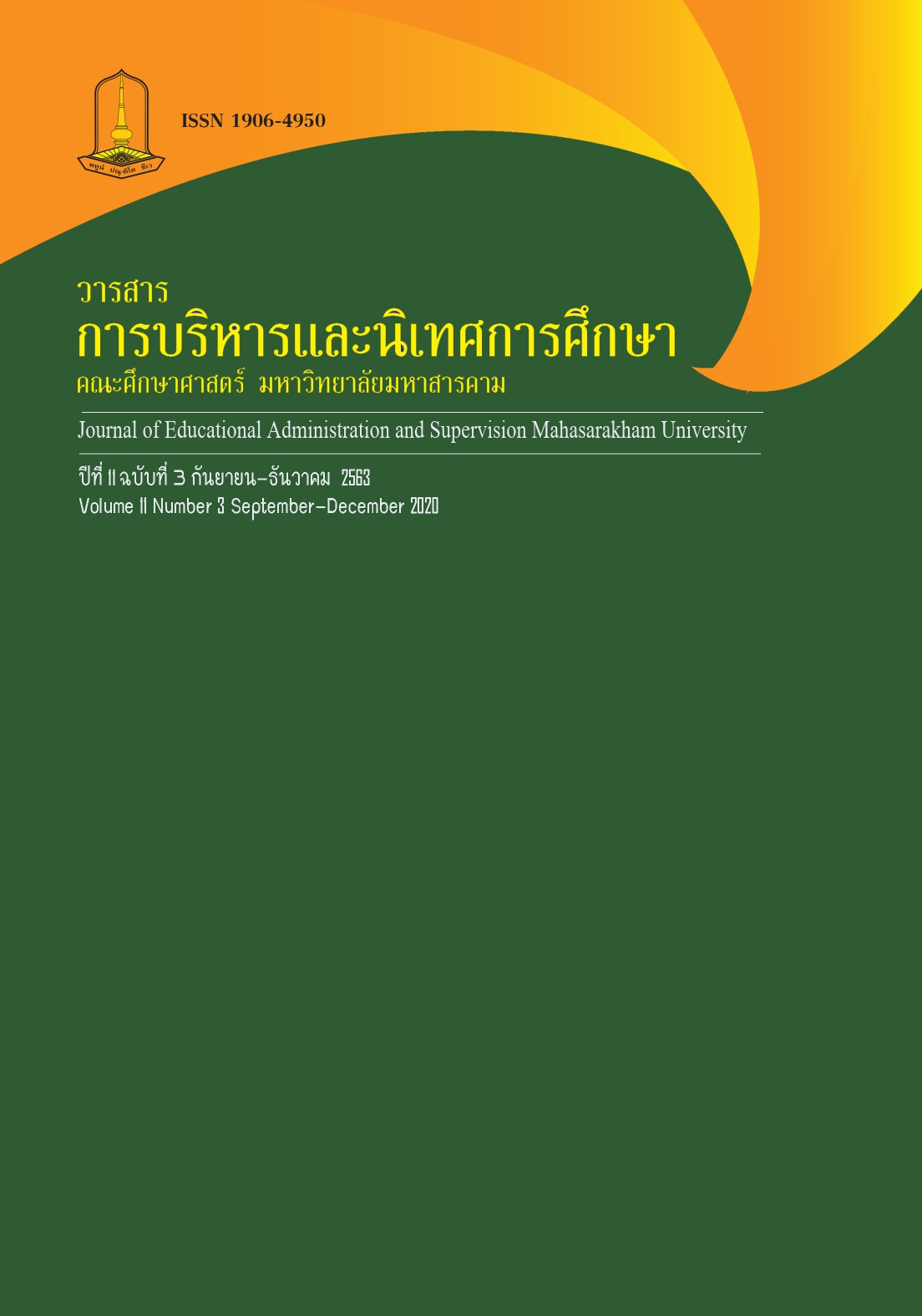การนำเสนอรูปแบบการส่งเสริมภาวะผู้นำด้านมารยาทในสังคมดิจิทัลด้วยวิธีสืบสอบสำหรับลูกเสือ
Main Article Content
บทคัดย่อ
การวิจัยในครั้งนี้มีวัตถุประสงค์เพื่อ 1) ออกแบบรูปแบบการเรียนรู้สืบสอบแบบผสมผสานเพื่อส่งเสริมภาวะผู้นำด้านมารยาทในสังคมดิจิทัลสำหรับลูกเสือ 2) ศึกษาความเห็นของผู้เชี่ยวชาญที่มีต่อรูปแบบการเรียนรู้สืบสอบแบบผสมผสานเพื่อส่งเสริมภาวะผู้นำด้านมารยาทในสังคมดิจิทัลสำหรับลูกเสือ โดยใช้วิธีวิจัยเชิงคุณภาพ กลุ่มตัวอย่างที่ใช้ในการวิจัย แบ่งเป็น 2 กลุ่ม ได้แก่ ผู้เชี่ยวชาญที่ระดมความคิดเห็นในการออกแบบรูปแบบฯ จำนวน 7 คน ได้แก่ 1) ผู้เชี่ยวชาญด้านเทคโนโลยีทางการศึกษาจำนวน 3 คน 2) ผู้เชี่ยวชาญด้านลูกเสือ จำนวน 4 คน และผู้เชี่ยวชาญที่แสดงความคิดเห็นที่มีต่อรูปแบบ จำนวน 5 คน เครื่องมือที่ใช้ในการวิจัยคือแบบสัมภาษณ์แนวทางในการออกแบบรูปแบบฯ และแบบประเมินความคิดเห็นที่มีต่อรูปแบบฯ ผลค่าดัชนีความสอดคล้องของข้อคำถามกับวัตถุประสงค์ (IOC)อยู่ในช่วง 0.8-1.0 สถิติที่ใช้ในการวิเคราะห์ข้อมูล ได้แก่ ค่าเฉลี่ย และค่าส่วนเบี่ยงเบนมาตรฐาน
ผลการวิจัย พบว่า
1. รูปแบบการเรียนรู้สืบสอบแบบผสมผสานเพื่อส่งเสริมภาวะผู้นำด้านมารยาทในสังคมดิจิทัลสำหรับลูกเสือ ประกอบด้วย 6 องค์ประกอบ ได้แก่ 1) เครื่องมือในการเรียนรู้ร่วมกันออนไลน์ 2) เนื้อหา3) แหล่งเรียนรู้เพิ่มเติม 4) กิจกรรมการเรียนรู้ 5) สภาพแวดล้อมการเรียนรู้ และ 6) การวัดและการประเมินผล
2. ผลการประเมินความเห็นของผู้เชี่ยวชาญที่มีต่อรูปแบบการเรียนรู้สืบสอบแบบผสมผสานเพื่อส่งเสริมภาวะผู้นำ ด้านมารยาทในสังคมดิจิทัลสำหรับลูกเสือ พบว่ารูปแบบที่พัฒนาขึ้น มีค่าเฉลี่ยความเหมาะสมอยู่ที่ 4.55 ซึ่งอยู่ในระดับมากที่สุดเหมาะสมต่อการนำไปใช้
Downloads
Article Details
เอกสารอ้างอิง
กนกวรรณ โพธิ์ทอง. (2559). ผลของภาวะผู้นำทางเทคโนโลยีของผู้บริหารโรงเรียนและบรรยากาศโรงเรียนโดยมีการรู้ เทคโนโลยีและการบูรณาการเทคโนโลยีในการสอนของครูเป็นสื่อกลางต่อประสิทธิผลครูใน โรงเรียนดีศรีตำบล ระดับมัธยมศึกษาสังกัดสำนักงานคณะกรรมการการศึกษาขั้นพื้นฐาน. วารสารวิชาการมหาวิทยาลัยอีสเทิร์นเอเชีย ฉบับวิทยาศาสตร์และเทคโนโลยี, 10(3). 255-269.
กมลวรรณ เภกะนันทน์. (2555). กลยุทธ์การพัฒนาภาวะผู้นำการเปลี่ยนแปลงของผู้บริหารระดับกลางของโรงเรียน ในเครือคณะภคินีเซนต์ปอล เดอ ชาร์ตร ในประเทศไทย. ดุษฎีบัณฑิต, จุฬาลงกรณ์มหาวิทยาลัย, กรุงเทพฯ.
กิตติรานีย์ ขวงพร. (2554). การพัฒนาแบบวัดทักษะภาวะผู้นำการเปลี่ยนแปลงในศตวรรษที่ 21 ของนิสิตนักศึกษาระดับปริญญาบัณฑิต. มหาบัณฑิต, จุฬาลงกรณ์มหาวิทยาลัย, กรุงเทพฯ.
ญาณี นาแถมพลอย. (2555). ผลของการจัดกิจกรรมการเรียนรู้บนสื่อสังคมออนไลน์ด้วยการสืบสอบแบบชื่นชมจากกรณีตัวอย่างที่มีต่อการคิดขั้นสูงสำหรับนักเรียนมัธยมศึกษาปีที่ 3: การวิเคราะห์เครือข่าย สังคมออนไลน์. มหาบัณฑิต, จุฬาลงกรณ์มหาวิทยาลัย, กรุงเทพฯ.
ทิศนา แขมมณี. (2554). ศาสตร์การสอน: องค์ความรู้เพื่อการจัดกระบวนการเรียนรู้ที่มีประสิทธิภาพ. พิมพ์ครั้งที่ 14. กรุงเทพฯ: สำนักพิมพ์แห่งจุฬาลงกรณ์มหาวิทยาลัย.
บุญธรรม กิจปรีดาบริสุทธิ์. (2553). เทคนิคการสร้างเครื่องมือรวบรวมข้อมูลสำหรับการวิจัย. พิมพ์ครั้งที่ 7. กรุงเทพฯ: สำนักพิมพ์แห่งจุฬาลงกรณ์มหาวิทยาลัย.
ประเวศ วะสี. (2557). ระบบการสร้างผู้นำสำหรับประเทศไทยยุคใหม่. นครปฐม: ศูนย์จิตตปัญญา มหาวิทยาลัยมหิดล.
ปราวีณยา สุวรรณณัฐโชติ. (2557). การออกแบบการเรียนการสอนแบบผสมผสานด้วยเทคโนโลยีเครือข่ายสังคมเพื่อขยายการมีส่วนร่วมในการเรียนของผู้เรียน. ใน ประกอบ กรณีกิจ, จินตวีร์คล้ายสังข์, บรรณาธิการ, รวมบทความเรื่องเทคโนโลยีและสื่อสารการศึกษา: นวัตกรรมการเรียนรู้แบบผสมผสาน (หน้า. 47-62). กรุงเทพฯ: สำนักพิมพ์แห่งจุฬาลงกรณ์มหาวิทยาลัย.
ปราวีณยา สุวรรณณัฐโชติ. (2561). วัคซีนคุ้มภัยคนยุคดิจิทัล. กรุงเทพฯ: ศูนย์ส่งเสริมการพัฒนานวัตกรรมตำราและเอกสารทางวิชาการ คณะครุศาสตร์ จุฬาลงกรณ์มหาวิทยาลัย.
มหาวิทยาลัยมหิดล. (2559). หลักสูตรการเข้าใจดิจิทัล (Digital LiteracyCurriculum), สืบค้นเมื่อ 1 มีนาคม 2562, จาก http://e-learnning.guest.in.th/course
วิทยา ดำรงเกียรติศักดิ์. (2558). มารยาทในการใช้อินเทอร์เน็ต (Netiquette). สืบค้นเมื่อ 1 มีนาคม 2559, จาก http://www.infocommmju.com/icarticle/images/stories/icarticles/ajwittaya/ digital/Netiquette-.pdf
อุทุมพร ชื่นวิญญา. (2554). การพัฒนารูปแบบการเรียนการสอนที่ผสมผสานรูปแบบ INFOHIO DIALOGUE และกระบวนการการเรียนรู้แบบสืบสอบ เพื่อเสริมสร้างการรู้สารสนเทศ ของนักเรียนมัธยมศึกษาปีที่ 1. ดุษฎีบัณฑิต, จุฬาลงกรณ์มหาวิทยาลัย, กรุงเทพฯ.
อุลิชษา ครุฑะเสน. (2556). แนวทางการพัฒนากระบวนการเรียนรู้เท่าทันสื่อของแกนนำเยาวชน. ดุษฎีบัณฑิต, มหาลัยสวนดุสิต, กรุงเทพฯ.
อุษา บิ้กกิ้นส์. (2555). การรู้เท่าทันสื่อและสารสนเทศ. สุทธิปริทัศน์, 26(80): 147-161.
Al-Jammal, K. (2015). Student Leadership: Basic Skills and Appropriate Activities International. Journal of Innovative Research & Development, 4(13): 20-39.
Jeff, M.C., & Julie, S.B. (2013). Teachers’ Transformation to Inquiry-Based Instructional Practice. Creative Education, 4(2): 132-142.
Harvey, S. (2003). Building Effective Blended Learning Programs. Educational Technology, 43(6): 51-54.
Schinkten, O. (2018). What is digital etiquette?. Retrieved December 19, 2019, from https://www.lynda.com/Classroom-Management-tutorials/What-digital-etiquette/440956/476077-4.html
Shea, V. (1997). The Core Rules of Netiuette. Retrieved March 19, 2019, from http://www.albion.com/netiquette/introduction.html
Stacey, E., & Gerbic, P. (2007). Teaching for blended learning––Research perspectives from on-campus and distance students. Education and Information Technologies, 12(3): 165-174.


